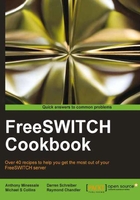
上QQ阅读APP看书,第一时间看更新
Conventions
In this book, you will find a number of styles of text that distinguish between different kinds of information. Here are some examples of these styles, and an explanation of their meaning.
Code words in text are shown as follows: "Many of the techniques employed in the Local_Extension are discussed in this chapter."
A block of code is set as follows:
<include>
<extension name="public_did">
<condition field="destination_number"expression="^(8005551212)$">
<action application="set" data="domain_name=$${domain}"/>
<action application="transfer" data="1000 XML default"/>
</condition>
</extension>
</include>
When we wish to draw your attention to a particular part of a code block, the relevant lines or items are set in bold:
<include>
<extension name="public_did">
<condition field="destination_number"expression="^(8005551212)$">
<action application="set" data="domain_name=$${domain}"/>
<action application="transfer" data="1000 XML default"/>
</condition>
</extension>
</include>
Any command-line input or output is written as follows:
perl -MCPAN -e 'install Regexp::Assemble'
New terms and important words are shown in bold. Words that you see on the screen, in menus or dialog boxes for example, appear in the text like this: "You should see an application named directory in the list."